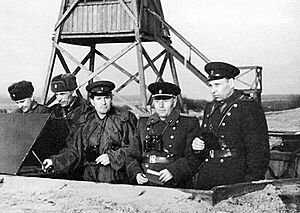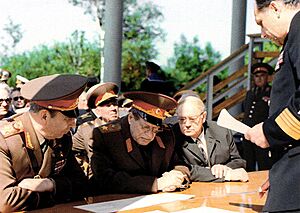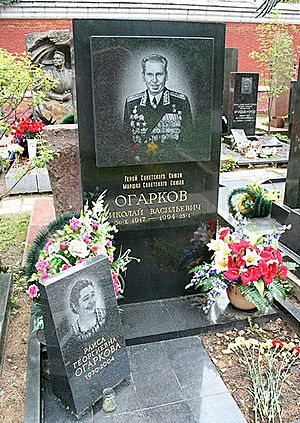Nikolai Ogarkov facts for kids
Quick facts for kids
Hero of the Soviet Union
Nikolai Vasilyevich Ogarkov
|
|
|---|---|
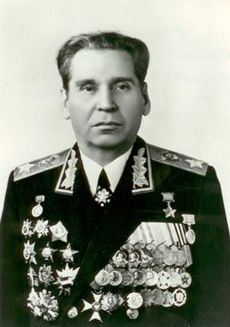 |
|
| Native name |
Николай Васильевич Огарков
|
| Nickname(s) | "Formidable soldier" «грозный солдат» |
| Born | 30 October 1917 Molokovo, Bezhetsky Uyezd, Tver Governorate, Russian Republic |
| Died | 23 January 1994 (aged 76) Moscow, Russia |
| Allegiance | |
| Years of service | 1937–1994 |
| Rank | |
| Commands held | Western theater of war command Soviet General Staff Volga Military District 20th Guards Motor Rifle Division |
| Awards | Hero of the Soviet Union |
Nikolai Vasilyevich Ogarkov (Russian: Николай Васильевич Огарков) was a very important military leader in the Soviet Union. He was born on October 30, 1917, and passed away on January 23, 1994. He became a Marshal of the Soviet Union in 1977, which is a very high military rank.
From 1977 to 1984, he was the Chief of the General Staff of the USSR. This means he was in charge of planning and leading the Soviet military. He became well-known around the world in 1983. This was when he spoke for the Soviet military after a passenger plane, Korean Air Lines Flight 007, was shot down. He was later removed from his top position on September 6, 1984.
Contents
Early Life and Education
Nikolai Ogarkov was born on October 30, 1917. His family were farmers in a village called Molokovo in the Tver region. When he was 14, he moved to the Russian Far East. There, he started working as a helper in a military shop.
In 1933, he went back to his hometown. For about a year and a half, he worked as an accountant and a secretary for local groups. Later, he moved to the Moscow area to study. He went to a special school for energy workers. After that, he studied civil engineering in Moscow.
Military Career Beginnings
Ogarkov joined the Red Army in 1938. He went to a special school for rifle and machinegun training. In 1941, he finished the Military Engineering Academy. He earned the rank of Military Engineer of the 3rd Rank.
World War II Service
When World War II started for the Soviet Union in 1941, Ogarkov was building defenses. He worked near the Łomża region as an engineer. He was part of the 1st Infantry Regiment.
From late 1941 to early 1942, he worked as a Senior Fortification Engineer. He was in the engineering department of the Karelian Front. After that, he became a Regimental Engineer for a rifle division.
In 1942, Ogarkov became a Brigade Engineer. He later served as an assistant to the chief of staff for the engineering troops of the 32nd Army. In 1943, he helped lead the engineering operations for the Karelian Front. By 1944, he was the Division Engineer for the 122nd Rifle Division.
He fought in many important battles during the war. These included the defense of Karelia and the Vyborg-Petrozavodsk attack. He also took part in the Petsamo-Kirkenes, Budapest, and Vienna offensives. In October 1944, he received the Order of the Patriotic War.
On April 11, 1945, Ogarkov was hurt in battle. He was leading sapper units, which are special engineering troops. He spent the end of the war in the hospital. In July, he returned to his division. A few months later, he became an assistant chief of staff for engineering troops. In the same year, he joined the Communist Party of the Soviet Union.
Rising Through the Ranks
After the war, Ogarkov continued his studies. He went to the Kuibyshev Military Academy again. In 1959, he finished the Military Academy of the General Staff. From 1945 to 1948, he worked in different engineering roles. He served in the Carpathian and Primorsky Military Districts. His good work caught the eye of commander Rodion Malinovsky. This helped his career grow.
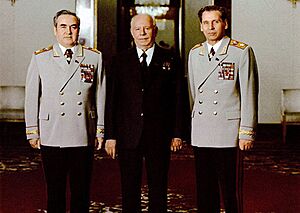
In 1948, he became a senior officer. By 1949, he was the head of an operational management department. He was promoted to Colonel in 1950. From 1953, he was deputy chief, then head of this department. He also became deputy chief of staff for the Far Eastern Military District. In 1957, he was promoted to Major General.
After graduating from the General Staff Academy in 1959, Ogarkov led the 20th Guards Motor Rifle Division. This division was part of the Soviet forces in East Germany. In 1961, he became chief of staff for the Belarusian Military District.
In 1965, he was appointed commander of the Volga Military District. In 1968, he became the first Deputy Chief of the General Staff of the USSR Armed Forces. He was also a member of the CPSU Central Committee, a very important political group. He served as a deputy in the Soviet of Nationalities, a part of the Soviet government. From 1974 to 1977, Ogarkov was the Deputy Minister of Defense of the USSR.
On January 8, 1977, General Ogarkov became the Chief of the General Staff. He was also the first Deputy Minister of Defense of the USSR. A few days later, on January 14, 1977, he was given the highest military rank: Marshal of the Soviet Union. In the 1970s, he helped with the Strategic Arms Limitation Talks. These were important talks to control nuclear weapons.
Ogarkov was against the Soviet invasion of Afghanistan in 1979. He had strong disagreements with Dmitry Ustinov, who was the Minister of Defense. Ogarkov was not afraid to challenge Ustinov on military and weapons development issues.
On September 1, 1983, a passenger plane, Korean Air Lines Flight 007, was shot down. It was a Boeing 747 with 246 passengers and 23 crew members. The plane had flown into Soviet prohibited airspace. The Soviet Air Force shot it down, killing everyone on board. Ogarkov appeared on television as the Soviet military's spokesman. He defended the decision to shoot down the plane. He said it was not an accident and was made by a local commander. They thought the plane was a reconnaissance aircraft on a spying mission.
Modernizing the Military
Ogarkov strongly believed the Soviet military needed to change. He wanted to make it smaller and more advanced. He thought it should use new technology. This idea was very different from the traditional way of fighting, which many older officers preferred. In 1984, he wrote an article about his ideas for modernizing the military.
During his time as Chief of the General Staff, Ogarkov planned and led huge military exercises. One of the biggest was called Exercise Zapad-81 in September 1981. This exercise was as big as major operations during World War II. It tested new control systems and precision-guided munitions (smart weapons). Ogarkov also focused on improving how Strategic Missile Forces were controlled.
Andrey A. Kokoshin, a former Russian official, said that Ogarkov was one of the first to think about a "revolution in military affairs." This means using new technologies to change how wars are fought.
Ogarkov's Removal

Ogarkov was removed from his positions on September 6, 1984. He was no longer Chief of the General Staff or First Deputy Minister of Defense. Sergey Akhromeyev took his place.
Some people believe his removal was linked to political struggles. Others, like Raymond L. Garthoff, think it was about disagreements over how much money should be spent on defense. Garthoff said there was no sign Ogarkov was involved in political fights. After being removed, Ogarkov was made commander of a new military command in the West.
Later Career and Retirement
From 1988 to 1992, Ogarkov worked as an inspector general for the Ministry of Defense. He also led a council for war veterans.
After the Soviet Union broke apart in 1991, he became an advisor. He advised the new Ministry of Defense of the Russian Federation. He also advised the Chief of the General Staff of the new military forces. His advice was very important for planning Russia's first state arms program.
Personal Life and Death
Nikolai Ogarkov was married to Raisa Georgievna Ogarkova. They had children and grandchildren.
Ogarkov passed away on January 23, 1994, in Moscow. He had been ill for a long time. He was buried with full military honors at the Novodevichy Cemetery.
Awards
Nikolai Ogarkov received many awards for his service.
- USSR
| Hero of the Soviet Union (1977) | |
| Two Orders of Lenin (1977, 1980) | |
| Order of the October Revolution (1987) | |
| Order of the Red Banner (1969) | |
| Order of Suvorov, 1st Class (1981) | |
| Two Orders of the Patriotic War, 1st class (1945, 1985) | |
| Order of the Patriotic War, 2nd class (1944) | |
| Two Orders of the Red Star (1954, 1967) | |
| Order for Service to the Homeland in the Armed Forces of the USSR, 3rd class (1975) | |
| Medal "For the Defence of the Soviet Transarctic" (1944) | |
| Medal "For the Capture of Budapest" (1945) | |
| Medal "For the Victory over Germany in the Great Patriotic War 1941–1945" (1945) | |
| Jubilee Medal "Twenty Years of Victory in the Great Patriotic War 1941-1945" (1965) | |
| Jubilee Medal "Thirty Years of Victory in the Great Patriotic War 1941–1945" (1975) | |
| Jubilee Medal "Forty Years of Victory in the Great Patriotic War 1941–1945" (1985) | |
| Jubilee Medal "In Commemoration of the 100th Anniversary of the Birth of Vladimir Ilyich Lenin" (1969) | |
| Jubilee Medal "30 Years of the Soviet Army and Navy" (1948) | |
| Jubilee Medal "40 Years of the Armed Forces of the USSR" (1958) | |
| Jubilee Medal "50 Years of the Armed Forces of the USSR" (1968) | |
| Jubilee Medal "60 Years of the Armed Forces of the USSR" (1978) | |
| Jubilee Medal "70 Years of the Armed Forces of the USSR" (1988) | |
| Medal "Veteran of the Armed Forces of the USSR" (1976) | |
| Medal "For the Development of Virgin Lands" (1956) | |
| Medal "For Strengthening of Brotherhood in Arms" | |
| Medal "For Impeccable Service", 1st class |
- Lenin Prize (1981)
- Foreign
| Order of The People's Republic of Bulgaria, 1st class (Bulgaria) | |
| Order of Military Merit (Bulgaria) | |
| Medal of Sino-Soviet Friendship (China) | |
| Order of the Red Banner (Czechoslovakia) | |
| Military Merit Medal (Czechoslovakia) | |
| Medal “For Strengthening Friendship in Arms”, Golden class (Czechoslovakia) | |
| Scharnhorst Order (East Germany) | |
| Order of the Flag of the Republic of Hungary, 1st and 3rd class (Hungary) | |
| Order of Sukhbaatar (Mongolia) | |
| Order of the Red Banner (Mongolia) | |
| Medal "30 Years of the Victory in Khalkhin-Gol" (Mongolia) | |
| Medal for the Liberation of Korea (North Korea) | |
| Order of Polonia Restituta, 3rd class (Poland) | |
| Brotherhood of Arms Medal (Poland) | |
| Order of Tudor Vladimirescu, 1st class (Romania) | |
| Military Exploit Order, 1st class (Vietnam) |
Legacy and Recognition
In 2003, a museum was opened in Molokovo, Ogarkov's hometown. The museum is named after him and shows items from his life. A special plaque honoring him was placed on the wall of his former home in Moscow.
In February 2018, one of the control rooms at the National Defense Management Center of the Russian Federation was also named after Nikolai Ogarkov. This shows how important he was to the military.



